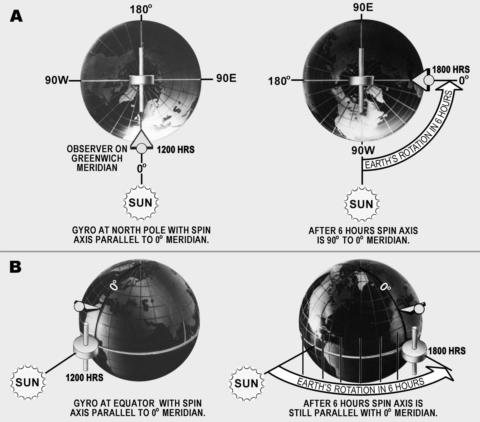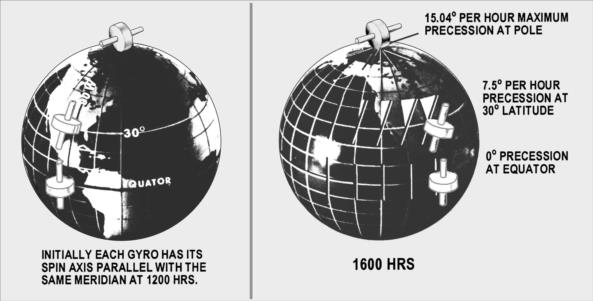
NavList:
A Community Devoted to the Preservation and Practice of Celestial Navigation and Other Methods of Traditional Wayfinding
Re: Coriolis and gyros (second attempt)(typos corrected)
From: Gary LaPook
Date: 2009 Aug 23, 16:10 +0200
From: Gary LaPook
Date: 2009 Aug 23, 16:10 +0200
I am attaching an excerpt from AFPAM 11-216, Air Navigation, which may
help explain the behavior of gyros and the Foucault Pendulum. These
both exhibit the "apparent precession" due to "earth rate"
which
make them appear to change direction at a rate of 15.04º per hour times
the sine of the latitude. The Foucault Pendulum, hanging in the
Pantheon in Paris, is located at 48º 50' 47" north latitude, the sine
of which is .7529 multiplied by 15.04º per hour produces a rate of
apparent precession of the pendulum of 11.32º per hour. The information
plaque near the pendulum states that it changes 11º per hour, obviously
rounded to the nearest whole degree for the tourists. Coriolis is not
involved since the Pantheon has not moved across the surface of the
earth since its foundations were laid in 1758 so its ground speed is
zero.
gl
Section 14D— Gyro Precession
14.13. Basics. To eliminate the difficulties imposed by magnetic compass unreliability in polar areas,
you disregard the magnetic compass in favor of a free-running gyro. Gyro steering is used because it is
stable and independent of magnetic influence. When used as a steering instrument, the gyro is restricted
so its spin axis always remains horizontal to the surface of the earth and is free to turn only in this
horizontal plane. Any movement of a gyro spin axis from its initial horizontal alignment is called
precession. The two types of precession are real and apparent, with apparent broken into earth rate,
transport, and grid transport precession. Total precession is the cumulative effect of real and apparent
precession.
14.14. Real Precession. Real precession, illustrated in Figure 14.9, is the actual movement of a gyro
spin axis from its initial alignment in space. It is caused by such imperfections as power fluctuation,
imbalance of the gyro, friction in gyro gimbal bearings, and acceleration forces. As a result of the
improved quality of equipment now being used, real precession is considered to be negligible. Some
compass systems have a real precession rate of less than 1o per hour. Electrical or mechanical forces are
intentionally applied by erection or compensation devices to align the gyro spin axis in relation to the
earth's surface. In this manner, the effects of apparent precession are eliminated and the gyro can then be
used as a reliable reference.
304 AFPAM11-216 1 MARCH 2001
Figure 14.9. Real Precession.
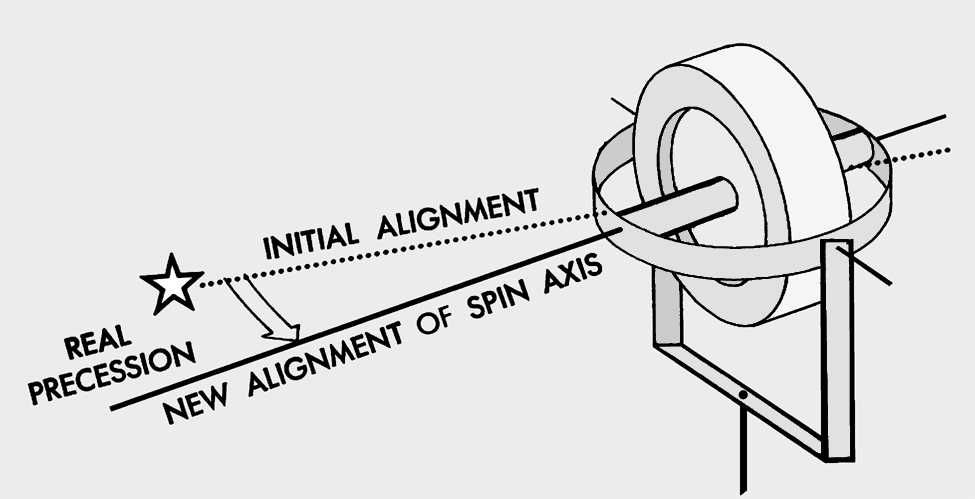
14.15. Apparent Precession. The spin axis of a gyro remains aligned with a fixed point in space, while
your plane of reference changes, making it appear that the spin axis has moved. Apparent precession is
this apparent movement of the gyro spin axis from its initial alignment.
14.15.1. Earth Rate Precession. Earth rate precession is caused by the rotation of the earth while the
spin axis of the gyro remains aligned with a fixed point in space. Earth rate precession is divided into
two components. The tendency of the spin axis to tilt up or down from the horizontal plane of the
observer is called the vertical component. The tendency of the spin axis to drift around laterally; that is,
to change in azimuth, is called the horizontal component. Generally, when earth rate is mentioned, it is
the horizontal component which is referred to, since the vertical component is of little concern.
14.15.2. Figure 14.10. A gyro located at the North Pole, with its spin axis initially aligned with a
meridian, appears to turn 15.04o per hour in the horizontal plane because the earth turns 15.04o per hour.
As shown in A of Figure 14.10, the apparent relationship between the Greenwich meridian and the gyro
spin axis will change by 90o in 6 hours, though the spin axis is still oriented to the same point in space.
Thus, apparent precession at the pole equals the rate of earth rotation. At the equator, as shown in B of
Figure 14.10, no earth rate precession occurs in the horizontal plane if the gyro spin axis is still aligned
with a meridian and is parallel to the earth's spin axis.
14.15.3. Vertical Component. When the gyro spin axis is turned perpendicular to the meridian (Figure
14.11), maximum earth rate precession occurs in the vertical component. But the directional gyro does
not precess vertically because of the internal restriction of the gyro movement in any but the horizontal
plane. Thus, for practical purposes, earth rate precession is only that precession which occurs in the
horizontal plane. Figure 14.11 illustrates earth rate precession at the equator for 6 hours of time.
14.15.4. Precession Variation. Earth rate precession varies between 15.04o/hr at the poles and 0o/hr at
the equator. It is computed for any latitude by multiplying 15.04o times the sine of the latitude. For
example, at 30o N, the sine of latitude is 0.5. The horizontal component of earth rate is, therefore,
15o/hour right x 0.5 or 7.5o/hour right at 30o N as shown in Figure 14.12.
AFPAM11-216 1 MARCH 2001 305
Figure 14.10. Initial Location of Gyro Affects Earth Rate Precession.
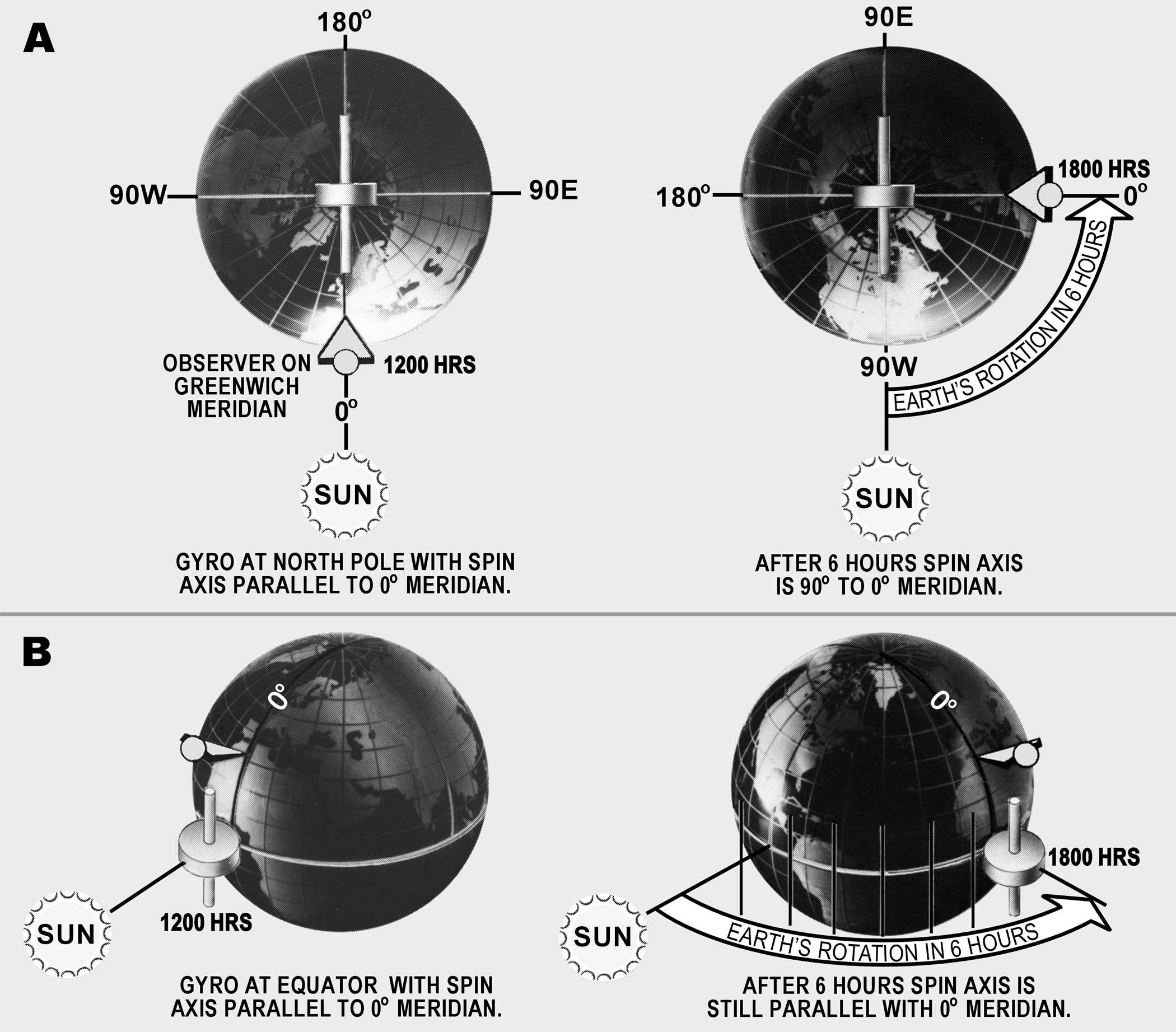
306 AFPAM11-216 1 MARCH 2001
Figure 14.11. Direction of Spin Axis Affects Earth Rate Precession.

Figure 14.12. Earth Precession Varies According to Latitude.
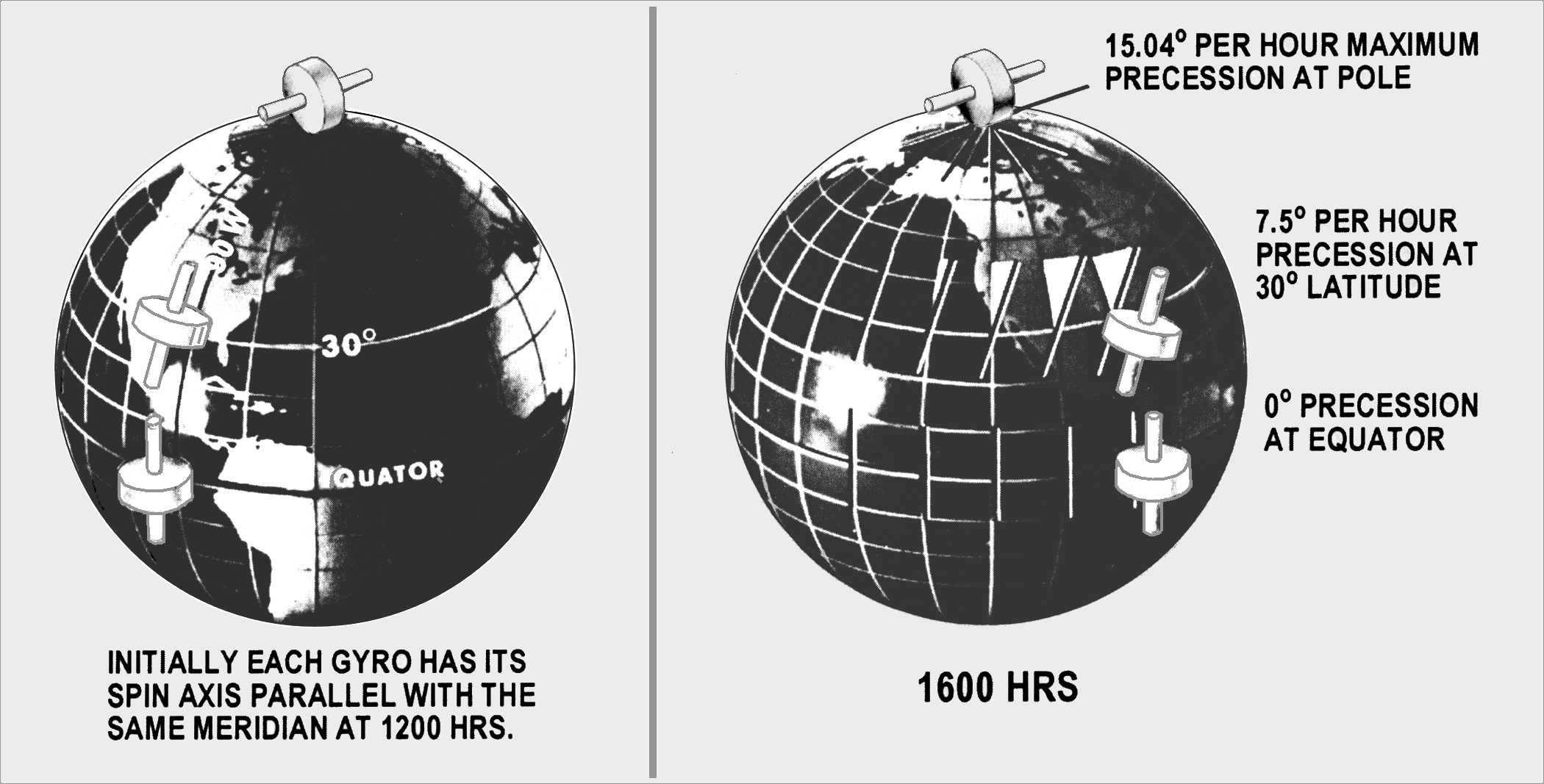
gl
Section 14D— Gyro Precession
14.13. Basics. To eliminate the difficulties imposed by magnetic compass unreliability in polar areas,
you disregard the magnetic compass in favor of a free-running gyro. Gyro steering is used because it is
stable and independent of magnetic influence. When used as a steering instrument, the gyro is restricted
so its spin axis always remains horizontal to the surface of the earth and is free to turn only in this
horizontal plane. Any movement of a gyro spin axis from its initial horizontal alignment is called
precession. The two types of precession are real and apparent, with apparent broken into earth rate,
transport, and grid transport precession. Total precession is the cumulative effect of real and apparent
precession.
14.14. Real Precession. Real precession, illustrated in Figure 14.9, is the actual movement of a gyro
spin axis from its initial alignment in space. It is caused by such imperfections as power fluctuation,
imbalance of the gyro, friction in gyro gimbal bearings, and acceleration forces. As a result of the
improved quality of equipment now being used, real precession is considered to be negligible. Some
compass systems have a real precession rate of less than 1o per hour. Electrical or mechanical forces are
intentionally applied by erection or compensation devices to align the gyro spin axis in relation to the
earth's surface. In this manner, the effects of apparent precession are eliminated and the gyro can then be
used as a reliable reference.
304 AFPAM11-216 1 MARCH 2001
Figure 14.9. Real Precession.
14.15. Apparent Precession. The spin axis of a gyro remains aligned with a fixed point in space, while
your plane of reference changes, making it appear that the spin axis has moved. Apparent precession is
this apparent movement of the gyro spin axis from its initial alignment.
14.15.1. Earth Rate Precession. Earth rate precession is caused by the rotation of the earth while the
spin axis of the gyro remains aligned with a fixed point in space. Earth rate precession is divided into
two components. The tendency of the spin axis to tilt up or down from the horizontal plane of the
observer is called the vertical component. The tendency of the spin axis to drift around laterally; that is,
to change in azimuth, is called the horizontal component. Generally, when earth rate is mentioned, it is
the horizontal component which is referred to, since the vertical component is of little concern.
14.15.2. Figure 14.10. A gyro located at the North Pole, with its spin axis initially aligned with a
meridian, appears to turn 15.04o per hour in the horizontal plane because the earth turns 15.04o per hour.
As shown in A of Figure 14.10, the apparent relationship between the Greenwich meridian and the gyro
spin axis will change by 90o in 6 hours, though the spin axis is still oriented to the same point in space.
Thus, apparent precession at the pole equals the rate of earth rotation. At the equator, as shown in B of
Figure 14.10, no earth rate precession occurs in the horizontal plane if the gyro spin axis is still aligned
with a meridian and is parallel to the earth's spin axis.
14.15.3. Vertical Component. When the gyro spin axis is turned perpendicular to the meridian (Figure
14.11), maximum earth rate precession occurs in the vertical component. But the directional gyro does
not precess vertically because of the internal restriction of the gyro movement in any but the horizontal
plane. Thus, for practical purposes, earth rate precession is only that precession which occurs in the
horizontal plane. Figure 14.11 illustrates earth rate precession at the equator for 6 hours of time.
14.15.4. Precession Variation. Earth rate precession varies between 15.04o/hr at the poles and 0o/hr at
the equator. It is computed for any latitude by multiplying 15.04o times the sine of the latitude. For
example, at 30o N, the sine of latitude is 0.5. The horizontal component of earth rate is, therefore,
15o/hour right x 0.5 or 7.5o/hour right at 30o N as shown in Figure 14.12.
AFPAM11-216 1 MARCH 2001 305
Figure 14.10. Initial Location of Gyro Affects Earth Rate Precession.
306 AFPAM11-216 1 MARCH 2001
Figure 14.11. Direction of Spin Axis Affects Earth Rate Precession.
Figure 14.12. Earth Precession Varies According to Latitude.

